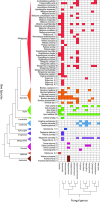Bees just wanna have fungi: a review of bee associations with nonpathogenic fungi
- PMID: 37422442
- PMCID: PMC10370288
- DOI: 10.1093/femsec/fiad077
Bees just wanna have fungi: a review of bee associations with nonpathogenic fungi
Abstract
Bee-fungus associations are common, and while most studies focus on entomopathogens, emerging evidence suggests that bees associate with a variety of symbiotic fungi that can influence bee behavior and health. Here, we review nonpathogenic fungal taxa associated with different bee species and bee-related habitats. We synthesize results of studies examining fungal effects on bee behavior, development, survival, and fitness. We find that fungal communities differ across habitats, with some groups restricted mostly to flowers (Metschnikowia), while others are present almost exclusively in stored provisions (Zygosaccharomyces). Starmerella yeasts are found in multiple habitats in association with many bee species. Bee species differ widely in the abundance and identity of fungi hosted. Functional studies suggest that yeasts affect bee foraging, development, and pathogen interactions, though few bee and fungal taxa have been examined in this context. Rarely, fungi are obligately beneficial symbionts of bees, whereas most are facultative bee associates with unknown or ecologically contextual effects. Fungicides can reduce fungal abundance and alter fungal communities associated with bees, potentially disrupting bee-fungi associations. We recommend that future study focus on fungi associated with non-honeybee species and examine multiple bee life stages to document fungal composition, abundance, and mechanistic effects on bees.
Keywords: Starmerella; Anthophila; microbiome; provision; symbiosis; yeast.
© The Author(s) 2023. Published by Oxford University Press on behalf of FEMS.
Conflict of interest statement
The authors have no conflict of interest to declare.
Figures



Similar articles
-
Symbiotic bacteria and fungi proliferate in diapause and may enhance overwintering survival in a solitary bee.ISME J. 2024 Jan 8;18(1):wrae089. doi: 10.1093/ismejo/wrae089. ISME J. 2024. PMID: 38767866 Free PMC article.
-
Non-target effects of agri-environmental schemes on solitary bees and fungi in the United Kingdom.Bull Entomol Res. 2022 Dec;112(6):734-744. doi: 10.1017/S0007485322000414. Epub 2022 Sep 9. Bull Entomol Res. 2022. PMID: 36082699
-
Specialisation of Yeast Genera in Different Phases of Bee Bread Maturation.Microorganisms. 2020 Nov 14;8(11):1789. doi: 10.3390/microorganisms8111789. Microorganisms. 2020. PMID: 33202620 Free PMC article.
-
Interactions between bee foraging and floral resource phenology shape bee populations and communities.Curr Opin Insect Sci. 2017 Jun;21:75-82. doi: 10.1016/j.cois.2017.05.015. Epub 2017 Jun 3. Curr Opin Insect Sci. 2017. PMID: 28822493 Review.
-
Structural diversity and functional variability of gut microbial communities associated with honey bees.Microb Pathog. 2020 Jan;138:103793. doi: 10.1016/j.micpath.2019.103793. Epub 2019 Oct 15. Microb Pathog. 2020. PMID: 31626917 Review.
Cited by
-
Gut Microbiome Diversity in European Honeybees (Apis mellifera L.) from La Union, Northern Luzon, Philippines.Insects. 2025 Jan 23;16(2):112. doi: 10.3390/insects16020112. Insects. 2025. PMID: 40003742 Free PMC article.
-
Exposure to a fungicide for a field-realistic duration does not alter bumble bee fecal microbiota structure.Appl Environ Microbiol. 2024 Feb 21;90(2):e0173923. doi: 10.1128/aem.01739-23. Epub 2024 Jan 19. Appl Environ Microbiol. 2024. PMID: 38240563 Free PMC article.
-
Symbiotic bacteria and fungi proliferate in diapause and may enhance overwintering survival in a solitary bee.ISME J. 2024 Jan 8;18(1):wrae089. doi: 10.1093/ismejo/wrae089. ISME J. 2024. PMID: 38767866 Free PMC article.
-
An Aspergillus flavus strain from bee bread of the Western honey bee (Apis mellifera) displays adaptations to distinctive features of the hive environment.Ecol Evol. 2024 Feb 22;14(2):e10918. doi: 10.1002/ece3.10918. eCollection 2024 Feb. Ecol Evol. 2024. PMID: 38389995 Free PMC article.
-
Diversity, antibacterial and antioxidant activities of fungi associated with Apis cerana.PeerJ. 2025 Aug 1;13:e19762. doi: 10.7717/peerj.19762. eCollection 2025. PeerJ. 2025. PMID: 40761805 Free PMC article.
References
-
- Al Naggar Y, Singavarapu B, Paxton RJet al. . Bees under interactive stressors: the novel insecticides flupyradifurone and sulfoxaflor along with the fungicide azoxystrobin disrupt the gut microbiota of honey bees and increase opportunistic bacterial pathogens. Sci Total Environ. 2022;849:157941. - PubMed
-
- Álvarez-Pérez S, Herrera CM. Composition, richness and nonrandom assembly of culturable bacterial-microfungal communities in floral nectar of Mediterranean plants. FEMS Microbiol Ecol. 2013;83:685–99. - PubMed

